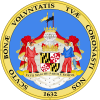Portal:Maryland
|
Maryland Portal
|
Baltimore Task Force
|
Frederick Task Force
|
Montgomery Task Force
|
WikiProject Maryland
|
|
Main page
|
Discussion
|
Introduction Maryland (US: /ˈmɛrɪlənd/ MERR-il-ənd) is a state in the Mid-Atlantic region of the United States. It borders Virginia to its south, West Virginia to its west, Pennsylvania to its north, Delaware and the Atlantic Ocean to its east, and the national capital of Washington, D.C. to the southwest. With a total area of 12,407 square miles (32,130 km2), Maryland is the ninth-smallest state by land area, and its population of 6,177,224 ranks it the 19th-most populous state and the fifth-most densely populated. Maryland's capital is Annapolis, and the most populous city is Baltimore. Maryland's coastline was first explored by Europeans in the 16th century. Prior to that, it was inhabited by several Native American tribes, mostly the Algonquian peoples. As one of the original Thirteen Colonies, Maryland was founded by George Calvert, 1st Baron Baltimore, a Catholic convert who sought to provide a religious haven for Catholics persecuted in England. In 1632, Charles I of England granted Lord Baltimore a colonial charter, naming the colony after his wife, Henrietta Maria. In 1649, the Maryland General Assembly passed an Act Concerning Religion, which enshrined the principle of toleration. Religious strife was common in Maryland's early years, and Catholics remained a minority, albeit in greater numbers than in any other English colony. Maryland's early settlements and population centers clustered around waterways that empty into the Chesapeake Bay. Its economy was heavily plantation-based and centered mostly on the cultivation of tobacco. Demand for cheap labor from Maryland colonists led to the importation of numerous indentured servants and enslaved Africans. In 1760, Maryland's current boundaries took form following the settlement of a long-running border dispute with Pennsylvania. Many of its citizens played key political and military roles in the American Revolutionary War. Although it was a slave state, Maryland remained in the Union during the American Civil War, and its proximity to Washington D.C. and Virginia made it a significant strategic location. After the Civil War ended, Maryland took part in the Industrial Revolution, driven by its seaports, railroad networks, and mass immigration from Europe. Since the 1940s, the state's population has grown rapidly, to approximately six million residents, and it is among the most densely populated U.S. states. As of 2015[update], Maryland had the highest median household income of any state, owing in large part to its proximity to Washington, D.C., and a highly diversified economy spanning manufacturing, retail services, public administration, real estate, higher education, information technology, defense contracting, health care, and biotechnology. Maryland is one of the most multicultural states in the country; it is one of the six states where non-Whites compose a majority of the population, with the fifth-highest percentage of African Americans, and high numbers of residents born in Africa, Asia, Central America, and the Caribbean. The state's central role in U.S. history is reflected by its hosting of some of the highest numbers of historic landmarks per capita. (Full article...) This is a Featured article, which represents some of the best content on English Wikipedia..
 The Maryland Tercentenary half dollar was a commemorative fifty-cent piece issued by the United States Bureau of the Mint in 1934. It depicts Cecil Calvert, 2nd Baron Baltimore on the obverse and the Coat of Arms of Maryland on the reverse. The Maryland Tercentenary Commission sought a coin in honor of the 300th anniversary of the arrival of English settlers in Maryland. The state's two senators introduced legislation for such a piece, and it passed both houses of Congress with no opposition. A design had already been prepared by Professor Hans Schuler; it passed review by the Commission of Fine Arts, though there was controversy then and since over whether Lord Baltimore, a Cavalier and Catholic, would have worn a collar typical of Puritans. (Full article...) General imagesIn the news
On this day...November 10
This is a Good article, an article that meets a core set of high editorial standards.
 Darvin Moon (October 1, 1963 – September 19, 2020) was an American self-employed logger and amateur poker player who was the runner-up of the 2009 World Series of Poker, (WSOP) US$10,000 no-limit Texas hold'em Main Event. It was his first time playing in the World Series of Poker. Moon, who taught himself how to play poker, ran a small logging company in the Maryland Panhandle before earning a 2009 World Series seat by winning a $130 satellite tournament. Moon earned the chip lead early in the tournament, and eventually entered the final table as the chip leader, with about 30 percent of the chips in play. Although Moon briefly lost the lead, he eventually regained it after eliminating veteran players like Steve Begleiter and Phil Ivey. Moon ultimately lost heads up against Joe Cada, earning Moon US$5.18 million for his second-place finish. (Full article...) Selected article - The Baltimore and Ohio Railroad (reporting mark BO) was the first common carrier railroad and the oldest railroad in the United States. It operated as B&O from 1830 until 1987, when it was merged into the Chessie System; its lines are today controlled by CSX Transportation. The railroad was founded to serve merchants from Baltimore who wanted to do business with settlers crossing the Appalachian Mountains. It would compete with several existing and proposed turnpikes and canals, including the Erie and Chesapeake and Ohio Canal. Building west from the port of Baltimore, the B&O reached Sandy Hook, Maryland, in 1834; Cumberland in 1842; the Ohio River at Moundsville, Virginia, in 1852; Wheeling, Virginia, in 1853; and in 1857, Parkersburg, Virginia, below rapids that made navigation difficult during parts of the year. (Full article...) Did you know?

SubcategoriesSelect [+] to view subcategories
TopicsRelated portalsAssociated WikimediaThe following Wikimedia Foundation sister projects provide more on this subject:
Discover Wikipedia using portals |






















































